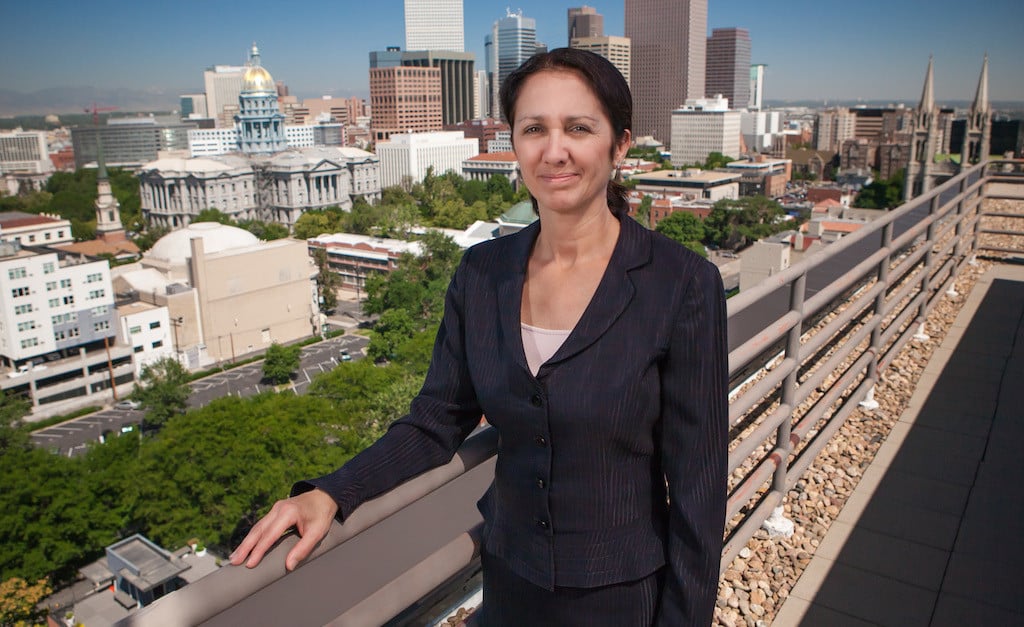The state of Colorado has a rich history of pioneers, dating back to the gold rush at Pike’s Peak in 1858. More than 150 years later, Colorado Public Employees’ Retirement Association maintains elements of that pioneering spirit.
The workplace is a climate-controlled office in downtown Denver and dress is business rather than under the open sky and ragged clothing, but Colorado PERA Chief Investment Officer Jennifer Paquette and her team hunt for undiscovered treasure just as the gold miners of yore did.
“Our early entry into some markets like private equity, real estate and international equity over the years, are examples of our willingness to innovate and take some risks where we think we’re going to get paid,” Paquette said. “We’re interested in what we can learn from others, but we are pretty determined to forge our own trail based on our own experiences, and using the risk tolerance of our board and our membership as a guide.”
That membership totaled 512,000 as of year-end 2013, including 200,000 active members, 186,000 inactive members, and 104,000 retirees. Colorado PERA oversees about $45 billion; as of year-end 2012, it was the 21st-largest U.S. state-sponsored public pension plan, between Pennsylvania Public School Employees’ Retirement System and Tennessee Consolidated Retirement System, according to an August 2013 Pension & Investments / Towers Watson report.
“we are pretty determined to forge our own trail based on our own experiences”
As of March 31, 2014, Colorado PERA had a 58% allocation to global equity, 24% to fixed income, 8% to alternatives, and 7% to real estate. The equity allocation leans toward the high end for public pension plans, Paquette said, while the alt-investment allocation — which notably does not include hedge funds — is on the low side.
“We’ve been in alternative assets, particularly private equity and real estate, for many decades and we continue to see interesting opportunities,” Paquette told Markets Media in a July 16 telephone interview. “But recently we’ve seen peers increasing allocations to those asset classes, as well as hedge funds and other alternatives, whereas our allocation hasn’t changed.”
Internal Management
Denver-based Colorado PERA manages more than 55% of its assets internally, compared with an average of about 25% for comparable large U.S. public pension plans. Four of every five dollars in the fixed-income portfolio is managed internally, all in actively managed strategies, while 65% of equities are managed in-house, spanning U.S., international, active and index.
The investment staff numbers 55, of whom 36 are analysts, portfolio managers, heads of asset classes, and other professionals directly involved in the investment-management process. “We’ve done internal management for many decades and I don’t anticipate a change in how much we do in-house,” Paquette said.

Jennifer Paquette, Colorado PERA
Pension plans typically farm out alternative investments to external managers and rely on consultants for how-to advice; Colorado PERA uses external managers, but allocates from within. “We don’t utilize gatekeepers or specialty consultants to help construct those portfolios,” Paquette said.
Paquette has been CIO for 11 years, a lengthy tenure for a public-investment leadership position. Colorado PERA generated an average annual return of 7.6% after fees for the 10 years ended December 31, 2013, compared with 6.9% for the median in a universe of comparable pension plans, according to Hewitt EnnisKnupp figures published in the Colorado PERA annual report.
“Over the last decade we’re a top-quartile performer versus a public funds universe,” Paquette said. “Long-term performance is quite solid.”
The fixed-income portfolio’s 5.1% average annual return beat its benchmark by about 20 basis points, or 0.2%, over the past decade. Colorado PERA’s equity holdings outperformed over one-year and three-year periods, and performed in-line over five years; there is no benchmark comparison presented for 10 years. Reported returns for alternative investments underperform by about 7 percentage points for the three-year and five-year periods, resulting in the total portfolio underperforming by 0.2 percentage points and 0.8 percentage points, respectively.
“They focus on some asset classes and they are quite careful in expanding to other asset classes.” – Roberto Caccia
“Our alternative asset class, which is our private equity asset class, is measured versus a public stock market index, plus a premium,” Paquette explained. “Private equity tends to lag the public stock market on the way up and on the way down, due to less frequent valuations and other reasons. That’s in the shorter term. Over the longer term, we expect private equity to exceed the public stock market plus the premium, and our private equity portfolio has delivered that.”
Colorado PERA started in 1931, with 1,400 members and $63,000 in assets. The next-most-challenging market period after that Great Depression era was arguably the global financial crisis of 2008-2009; Colorado PERA’s investments lost 26% of their value in 2008, but the plan bounced back with 17% and 14% returns in 2009 and 2010. “Our board and senior leadership team maintained a long-term focus when people were very concerned about the future of our financial markets in 2008,” Paquette said. “Our staff managed our portfolios well and our market experience allowed us to see some opportunities.”

Roberto Caccia, University of Colorado Boulder (Photo by Casey A. Cass/University of Colorado)
Aside from investment performance, both overall and specifically in the wake of the financial crisis Paquette cited a trio of needle-moving accomplishments: bolstering risk management, both quantitative and qualitative; emphasizing the ‘culture’ of the organization, through the integrity, competence and credentials of the investment professionals; and cultivating a broad strategic plan 30,000 feet above the day-to-day demands of portfolio management.
“We need to be deliberate about taking broader assessments for how to improve our overall investment strategy, as well as how we manage our staff,” Paquette said. It’s important to ensure “that we’re not just running portfolios well, but that we’re trying to foresee how to support our investments and people,” she added.
Roberto Caccia of the University of Colorado Boulder’s Leeds School of Business has worked with Paquette and Colorado PERA in providing finance students with exposure to the investment world via on-site visits and internships.
The pension plan’s investment professionals “are quite careful,” said Caccia, who worked at Goldman Sachs in commodities, credit and risk management for 14 years before moving to academia. “They focus on some asset classes and they are quite careful in expanding to other asset classes.”
“The investment team seems to be quite knowledgeable and they follow the markets closely,” Caccia continued. “There is careful risk management, which resonated with me because that was my last role at Goldman.”
Macro View
Paquette is “constructive” on the outlook for global markets, though not especially bullish. “We see the global economy as slowly healing and we observe uneven growth across different regions,” she said. “Growth has been slow but positive, and inflation expectations remain anchored.”
As is the case with most public-pension plans that invest for multi-decade periods, Colorado PERA steers its asset allocation like a battleship rather than a speedboat; short-term, tactical views are expressed within asset classes. “We are allocating assets for the longer term,” Paquette said. “A view on how emerging markets might perform in the shorter term might be expressed in our emerging-market debt or emerging-market equity portfolios, but it’s not going to drive a large shift within the total fund.”

As of year-end 2013, Colorado PERA’s $313 million stake in Apple was its biggest equity holding, followed by Google, ExxonMobil, Chevron, Microsoft, and Novartis. The pension plan’s largest bond holdings were U.S. Treasury notes, most with maturities between 2015 and 2019.
But where five-year Treasurys yielded more than 10% in the early 1980s, between 6% and 8% for much of the 1990s, and almost 5% as recently as April 2007, the risk-free rate of return has been less than 2% for more than three years, and was at 1.7% in late July. Amid the secularly low yields — and correspondingly low expectations for equities — the Colorado PERA Board of Trustees in November 2013 reduced the annual return assumption from 8% to 7.5%.
“We see the global economy as slowly healing and we observe uneven growth across different regions,”
“It was a responsible and conservative approach,” Paquette said. “I have confidence in the board’s process for coming to that 7.5% return assumption. I have learned from over 25 years of investment experience that calling returns for short-term periods is problematic, but considering expectations for our asset classes over longer-term periods is a prudent way to consider what the portfolio can earn over many decades.”
Colorado PERA’s funded ratio was 60.4% as of year-end 2013. The plan’s funded status based on market value ranked 56 among the 100 largest U.S. public pension plans, according to the Milliman 2013 Public Pension Funding Study.
One long-term fix for pension plans’ funding shortfalls would be meaningfully higher interest rates; however, rising rates crater bond prices, causing short- and even medium-term pain on the way up. Colorado PERA is well-positioned to weather the next leg of the cycle, according to Paquette.
“One of the reasons that interest rates might increase is a perceived or actual increase in the rate of inflation,” she said. “Our portfolio is well-diversified and includes assets such as stocks, commodities and real estate which, in a moderate inflation environment, we would expect to perform well. We’re not currently layering on strategies at the total fund level to specifically address the potential that short-term interest rates rise, but we are looking at how we want to manage the portfolio and allocate assets over the longer term.”
Many large public pension plans include hedge funds as part of their alternative-investment portfolio, for purposes such as diversification and inflation protection. Hedge funds have generally gained institutional support over the years, though more recently that trend has shown sign of wear, as the giant California Public Employees’ Retirement System and some other public entities have pulled back.
Colorado PERA hasn’t bought into the hedge-fund story, though the organization is taking another look. “We’ve hesitated to invest in hedge funds on some common concerns, such as transparency, fees, the complexity of strategies, the uncertainty of sustainable alpha production, and headline risk,” Paquette said. “That said, hedge-fund strategies have evolved over time, so we want to take a fresh look to see if some of those risks have been mitigated.”
As a long-term investor, Colorado PERA doesn’t turn over positions frequently, but given the size of the asset base, trades made from its internally managed stock and bond portfolios still generated $13.2 million in commissions for Wall Street brokers in 2013.
In equities, “we use a wide variety of broker relationships and different strategies to execute our trades,” Paquette noted. “We participate in both lit and dark trading venues. We tend to be patient traders, typically using price limits and reserving the right to cancel orders as needed. We use algorithmic offerings and also high-touch trading desks as appropriate.”
“U.S. equity market structure has become increasingly fragmented and complex, and that has amplified the increase in the use of fast execution and trading communications,” she added. “The result has enabled certain market participants, including high-frequency traders, to engage in potentially harmful behavior.”
As a long-term investor, Colorado PERA is fairly well-insulated from the moment-by moment cacophony of the market — but only until a stock needs to be bought or sold. “Certainly we have some exposure” to potentially exploitative trading strategies, Paquette said. In addition to deploying limit orders and cancelling trade orders, “we can transact at market closing price, which limits many of the technology and speed advantages that high-frequency traders may have…we’re looking to mitigate risks when we consider how to execute our trades.”
The fixed-income market presents more in the way of exogenous factors beyond traders’ control. “There is reduced market liquidity, which has led to less active trading,” Paquette said. “We find when the new issue market for credit is robust, that provides opportunities to trade and reposition the portfolio, while keeping transaction costs manageable. We factor in the lower liquidity when we build our investment strategy — we don’t have an expectation that liquidity is going to improve.”

The Colorado PERA building (Photo courtesy of Colorado PERA)
Colorado PERA makes “modest” use of derivatives such as futures, options and swaps, mostly via external managers who oversee commodities, international equity, and risk-parity strategies.
Paquette is a CFA charterholder who worked for Merrill Lynch and Alliance Capital before joining Colorado PERA. Married with three teenage sons, she is a dressage rider and yoga practitioner in her spare time.
Early Mover
Public pension plans historically have been stodgy investors, with plain-vanilla allocations along the lines of 60% in domestic stocks and 40% in bonds. That has been changing — slowly — in recent years, as the institutional asset owners branch out for purposes of diversification, risk management, and improved returns.
Colorado PERA first invested in real estate and other alternative investments in the late 1970s and early 1980s, according to plan spokesperson Katie Kaufmanis. In 1987, the Board authorized an allocation of as much as 15% for foreign securities. Currently, the pension plan is evaluating whether to invest in frontier markets, whose risk profile can be likened to what emerging markets were 20 or 25 years ago.
“We’re also willing to say no to strategies,” Paquette said, citing ‘portable alpha’ as something that was passed on. “Innovation that introduces complexity and risks that are not well compensated for, we try to avoid. We want to avoid expensive investment fads by avoiding the urge to seem sophisticated and run with the herd, unless we think there’s real value to be had.”
“We have a sustainable and well-managed plan,” Paquette concluded. “We continue to look for ways to innovate and try and manage in a prudent way utilizing best practices, as well as our own unique ideas. When I look at our past it speaks to a solid future for us.”
Featured image via naughtynut/Dollar Photo Club

